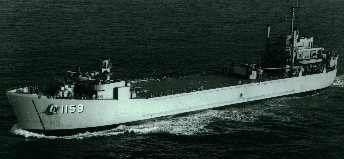
The Second Cruise
(April 1955 to May 1958)

Tom Green saw no hostile action during the second cruise. Looking back, those who served during other cruises under hostile conditions rate worthy salutes: and all 700 to 800 men who served aboard Tom Green from 1953 until 1972 can be proud of both ship and individual accomplishments. Perhaps that explains our feeling of companionship now.
April 1955 Tom Green County began a period of local operations out of San Diego.
Our primary liberty ports in California were San Francisco and San Diego. As many Tom Green Sailors know, exercises with the SEALS off San Clemente Island meant fresh on-board West Coast lobster for the evening meal. After working, the SEALS would dive to the underwater cliffs and pull "Langusta"from their holes and bring them aboard to waiting cooks on the main deck. There they were broiled on expanded metal screens, fitted over halved 50 gallon drums
Second cruise Sailors will recall more than just training, transport and logistic assignments while serving aboard Tom Green County. Most remember the Friday evening "drag races" to Point Loma by ships returning from weekly off-coast exercises. It was "first come, first served" at the narrow harbor entrance, before proceeding in column, tying up at a pier, and hearing "liberty call". Harbor pilots and tugs didn't work after dark, so some returning ships had to steam over night, meaning no Friday night liberty. Tom Green always entered San Diego harbor if arriving at night, and used her LCVPs as tugs to "nudge" the ship alongside a pier. More than once liberty was granted after a midnight arrival. Some Sailors couldn't have enjoyed more than three or four hours of liberty before returning for morning muster. But if Mama or Suzie was waiting, you had to hit the beach.
On 14 October, the tank landing ship entered the Mare Island Naval Shipyard at Vallejo, Calif., for a four-month yard period which lasted until February of 1956.
The distance between the dry docks of the Mare Island and Hunters Point Shipyards is roughly 25 miles. Tom Green steamed some 25,000 miles between the yards dry docks.
![]()
During the 4 month yard period at the Mare Island Naval Shipyard Tom Green Countys' single 3 inch 50s were replaced with twin 3 inch 50s. This increased the fire power of the vessel significantly.
![]() Moving back to San Diego following the overhaul,Tom GreenCounty departed the west coast for her second Far East deployment on 24 April. Leaving San Diego for WESTPAC brought the usual goodbyes. hugs and kisses,and promises to write.
Moving back to San Diego following the overhaul,Tom GreenCounty departed the west coast for her second Far East deployment on 24 April. Leaving San Diego for WESTPAC brought the usual goodbyes. hugs and kisses,and promises to write.
Tom Green arrived at Pearl Harbor on 4 May. Three days in Pearl Harbor and liberty in Honolulu gave the Strikers their first taste of being "overseas". There was Diamond Head to see and Waikiki Beach to check out. Old hands did whatever they did the last time they passed through.
![]()
Enroute from San Diego to WestPac during 1956, Tom Green County sailed alone from Pearl Harbor to Yokosuka. After several days of heat, high humidity, and glassy seas, the crew understanably became somewhat bored, irritable, and tired of drills.
So, one Sunday afternoon in mid-Pacific we stopped the ship, lowered the bow ramp part way, launched our LCVPs with riflemen to guard against possible sharks, and held a swimming party.
It seemed to work wonders
Several crewmen wondered about swiming in 5,000 foot deep water, but others suggested that the idea was to swim only on the surface.
![]() Underway on 7 May, the ship made port at Yokosuka on the 24th and operated in the Far East for the remainder of 1956. We soon learned the best places to eat and drink; which tourist and cultural places to visit; how to get there; and how to make ourselves understood. The Datsun and Toyota taxicabs were too small, used the wrong side of the road; and many cabbies seemed like banned race car drivers. Outside the main gate, some of us never got past "the first place on the right"; while others took the train to Tokyo and Yokohama, visited Shrines, rented bicycles to tour the surrounding countryside, and stopped at quaint Japanese Inns.
Underway on 7 May, the ship made port at Yokosuka on the 24th and operated in the Far East for the remainder of 1956. We soon learned the best places to eat and drink; which tourist and cultural places to visit; how to get there; and how to make ourselves understood. The Datsun and Toyota taxicabs were too small, used the wrong side of the road; and many cabbies seemed like banned race car drivers. Outside the main gate, some of us never got past "the first place on the right"; while others took the train to Tokyo and Yokohama, visited Shrines, rented bicycles to tour the surrounding countryside, and stopped at quaint Japanese Inns.
Sasebo was Tom Greens second most visited port, and as in Yokosuka, we soon learned the best sources for recreation. Enroute between Yokosuka and Sesebo, we several times entered and passed through the Inland Sea of Japan, which is a beautiful passage, but dotted with islands and crowded with marine traffic. During one night passage, we were suddenly surrounded by hundreds of lighted surface flares. The torches were attached to small Japanese fishing boats; and lighted when the fishermen heard the ship approaching. The small wooden boats did not show up on our radar.
During the second cruise, overseas ports included Pearl Harbor, Yokosuka, Yokohama,Sasebo, Nagasaki, and Atsugi in Japan. Iwakuni, ,Buckner Bay and Naha,Okinawa, Pohang in Korea, Sattahip near Bankok, and others.

Nagasaki Harbor
We were impressed with Nagasaki by the giant figure pointing skyward at ground zero of the atom bomb which helped end WWII. A museum displayed the glass bottles melted into globs by the heat, melted metal and household objects, and many photos of destruction.
Our second cruise mission was primarily training,transport and logistics, and we did that job well - even won the "E". We transported and helped train US Marines and Army troops, Navy Underwater Demolition Teams (SEALS), Royal Thai Marines, and other unremembered combat units. We conducted the usual on-board drills, seamanship, gunnery, communications and engineering exercises. We trained with other ships of LANDSHIPRON 5 in underway formations and manueuvering, amphibious operations, and other exercises we barely remember today.
We transported men, tanks, artillery pieces, LVTs, aircraft, combat vehicles, bulldozers, cherry pickers, cargo, and most anything else one can think of. At times it seemed the general plan was to move everything in the northern area of WESTPAC to the southern part - and vice versa.
![]()
Crew Comments
The trip to Inchon was to pick up wrecked Marine LVTs before returning to the States. I remember this incident because I had been relieved from my watch and was getting ready to hit the sack after being topside. In the dark, and in dense fog, a Japanese fishing trawler collided with LST 1159. The trawler hit the starbd side of the vessel dead on a frame member in a berthing compartment, knocking several sailors out of their bunks. The collision made one hell of a racket.
For a brief period period of time no one really knew what was going on because the Chemical Attack alarm sounded, but we went to our stations. As I recall I went to my station in the pump room and by the time I got plugged into the 1JV the Engineering Officer, Mr Neuzil, arrived and ordered me to pump all the ballast I could to port. I still remember how difficult it was to turn those big valves by myself.
Further assesment revealed the trawler did not punch a hole in our hull. After hoving too and boarding the trawler we got underway for Inchon again. We picked up the Marine LVTs, and a seaplane retriever at another location and transported them to Iwakuni. After offloading at Iwakuni we again got underway for Sasebo where the hull repairs were completed.
The variable pitch propellers could be controlled by the engine room(which was normal)or from the bridge. Bridge has control for closer and faster speed changes. When we were hit and in the confussion the bridge kept giving the engine room bells to stop(over and over), then to back down, then emergency back down. The engine room kept telling the bridge they had control. Finally the CO called down and wanted to know why we were not answering bells. We repeated the bridge had control. Control was shifted to the engine room and we backed down and stopped so the ship could anchor.
OF COURSE, the engine room crew was so efficient, the engine log and the bell book was current with all speed changes and engine data. It seems the bridge had not had time to start the deck log for the day yet. I refused to let the engine log out of my sight until the data was transferred to the deck log.
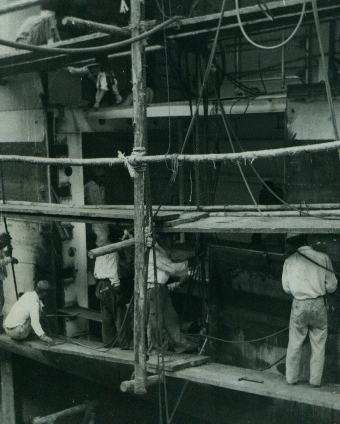
| Dry docked in Sasebo after being rammed by a Japanese vessel in the China Sea. Wooden posts lashed together make up rigging that would not pass muster in the US of A. I see 8 men working on the replacement of the damaged steel plate |
| In this photo you can see the steel plate was damaged to below the water line and had to be replaced. | 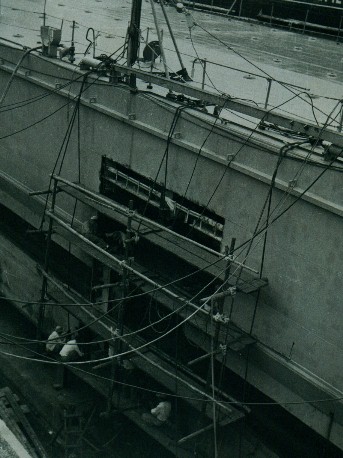 |
One side note--When we were in dry dock and the damaged area cut out, it made the best Liberty hole ever. We would get off watch, leave through the hole, walk out of the dry dock to the bar on top of the hill for a little R and R. It seems the bar was not there when we pulled in, but open within hours.
When entering or leaving the bar on the top of the hill an open sewer trench had to be crossed on a wooden plank. Going in was easy. Coming out was sometimes more difficult. A Fireman from our ship had "too much R&R" sliped off the plank leading over the sewer trench. His shipmates had to tie their neckerchiefs together to pull him out, then hose him off before he could go back to the ship. They were worried that the scratches he got from falling into the sewer trench would get infected from whatever was in the trench.
![]()
In the fall of 1956, we received a Squadron Commodore aboard, who had served much time aboard Destroyers and regularly talked about their superiorities. A month or so later, we were on a steep-gradient beach somewhere in Korea to load vehicles. The Commodore had read the caution that one should always step off the side, rather than the front edge of a grounded bow ramp; lest the ship suddenly surge forward and crush the legs. His problem was in mis-judging the water depth as he stepped into 6-7 feet of water. The crew lining the bow rail thoroughly enjoyed the entertainment, but someone thoughtfully rescued the Commodores floating hat.
![]()
 | Tom Green County also steamed to Hong Kong |
During our heavy work and operating schedule we were dispatched to Hong Kong for five days of R & R. Our anchorage was close in, and the liberty schedule was generous. We saw much of Hong Kong and Kowloon. Excellent bargains in clothing, and regular indulgance in food and drink soon took a heavy toll on our wallets.
| This was followed by a visit to Iwo Jima, before returning to Yokosuka on 22 November. |  Iwo Jima Memorial |
We practice landed US Army troops on Iwo Jima, where the beach looked like coffee grounds, and both men and machines sank 8 inches into the loose sand. We took a a unit of Royal Thai Marines for practice landings near the Burmese border, accompanied by a small gunboat that mounted one 12 inch gun, salvaged from somebody's battleship. Whether fact or scuttlebutt, it was reported that the gun could only fire directly forward - recoil from broadside fire caused the 160 foot gunboat to roll dangerously.
During extensive cruising, Tom Green endured three typhoons. At sea we rode out 50-60 foot swells, and ate mostly sandwiches and food from soup bowls. The third typhoon was spent steaming to a buoy in Sasebo Harbor for 24 hours, using underway watches. Meterorologists goofed up the weather warnings until it was too late to leave port.
On 23 January 1957, the tank landing ship departed Japanese waters for Hawaii and reached Pearl Harbor on 9 February.
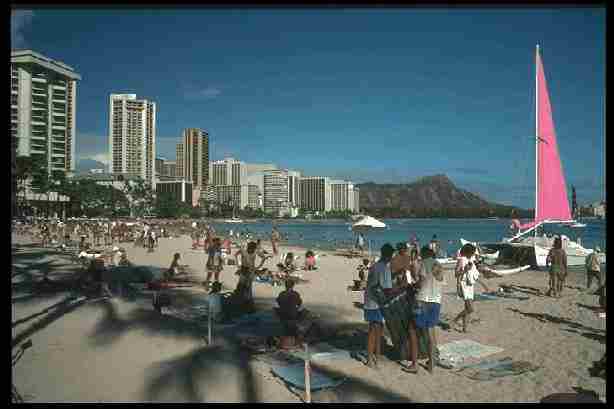
Waikiki Beach and Diamond Head
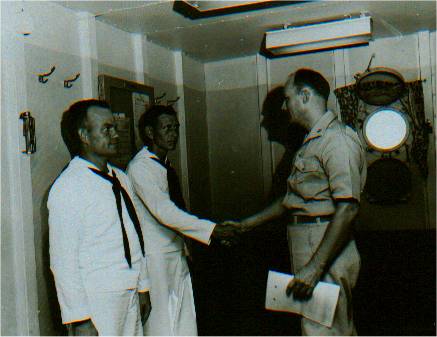
During May 1957 Seamen Applegate and Paxton were granted awards by Captain Schweinefuss in the Officers Wardroom.
The Change of Command occcured during November 1957 aboard the Tom Green County while in the port of San Francisco. The photo below records the Change of Command ceremony.
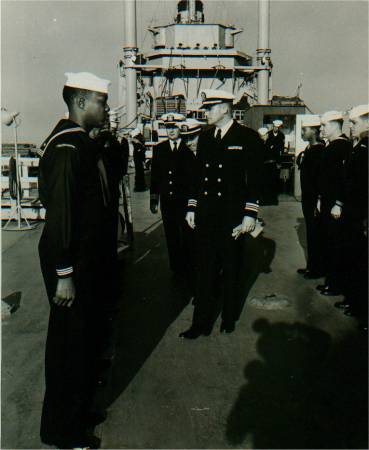
Following the Change of Command ceremony the Captain, Mrs. Schweinefuss, and the crew participated in a farewell party.


This ends the second cruise of Tom Green County.
It should be obvious that the straight historical facts of this cruise have been generously augmented by crew impressions. It is the impressions of the crew that now makes this an interesting narative rather than a dry stating of facts. Much more happened during Tom Green County's second cruise and shipmates are invited to add their stories to these impressions.
 people have visited this page
people have visited this page

![]() *Go to The Next Cruise*
*Go to The Next Cruise*
![]() *Return to Table of Contents*
*Return to Table of Contents*



![]()
